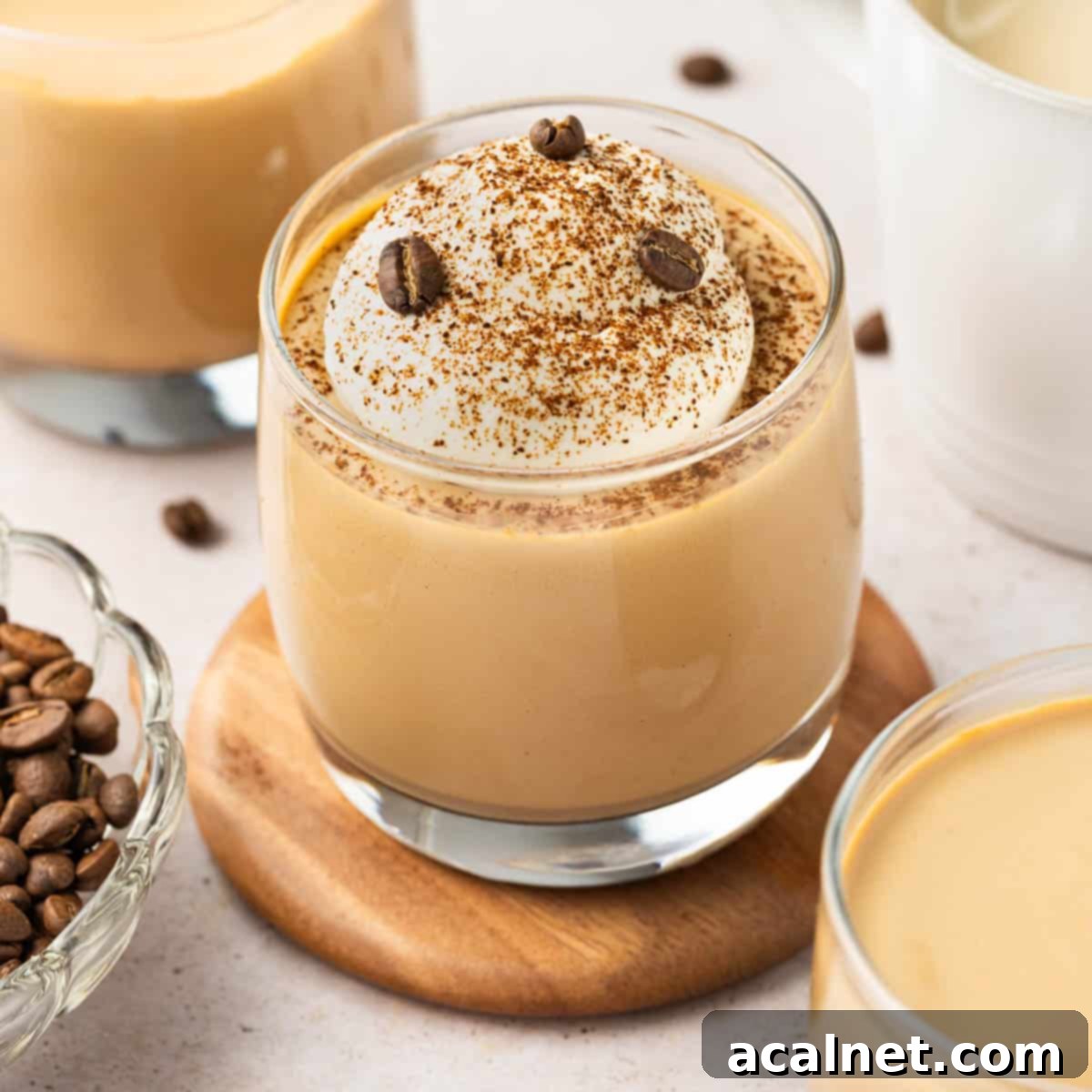Easy & Creamy Coffee Panna Cotta Recipe: Your Guide to a Delicious No-Bake Dessert
Discover the ultimate no-bake indulgence with this incredibly easy and wonderfully creamy Coffee Panna Cotta recipe. Crafted with just 5 essential ingredients and ready in less than 15 minutes of active preparation time, this elegant dessert is a showstopper without the fuss. Whether you’re hosting a sophisticated dinner party or looking for a special treat to elevate an ordinary evening, this coffee-infused panna cotta promises to impress with its rich espresso flavor and delicate, silky texture. It’s the perfect make-ahead option, allowing you to enjoy your guests (or simply relax) while your dessert chills to perfection.
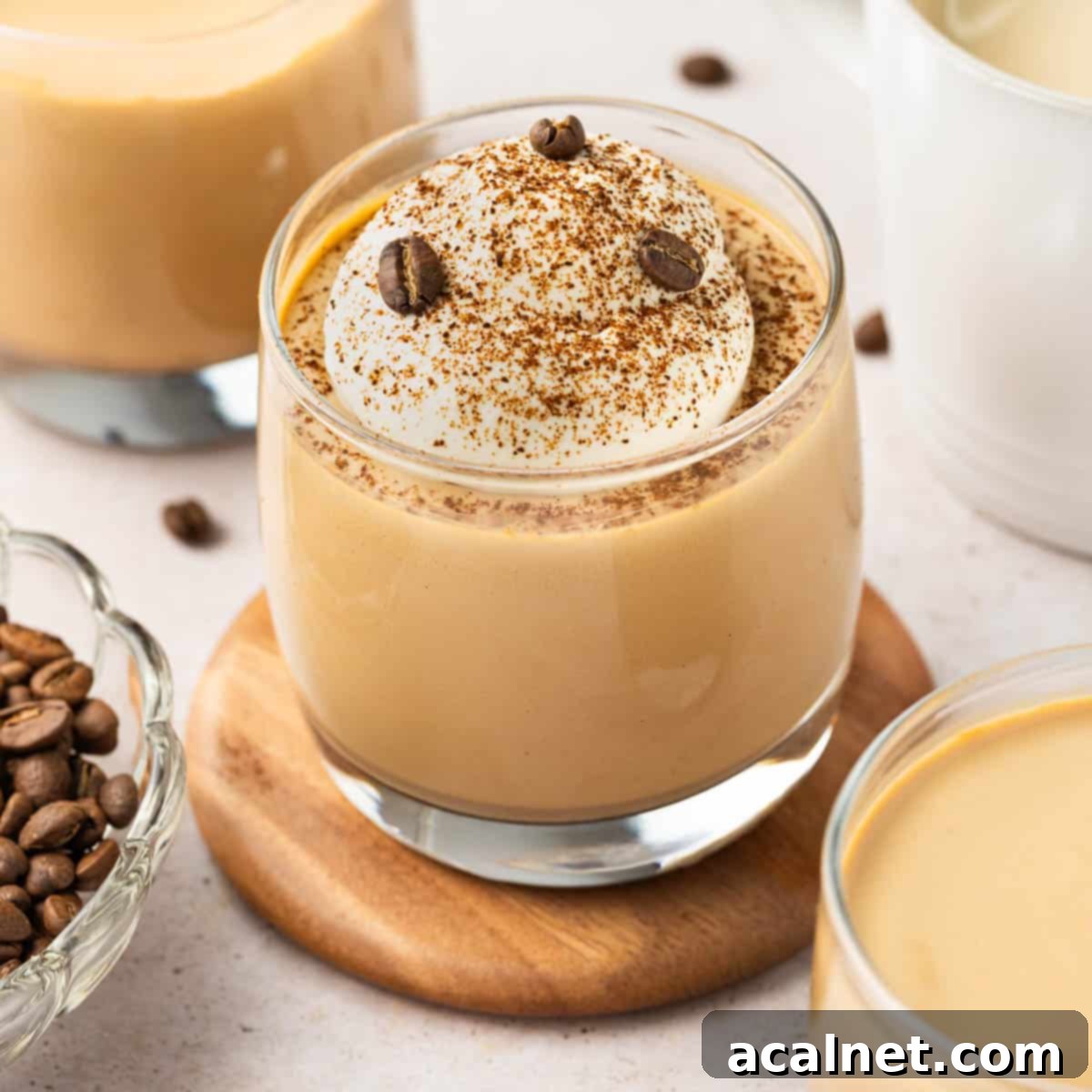
[feast_advanced_jump_to]
Why You Will Adore This Coffee Panna Cotta
When it comes to desserts that offer both incredible flavor and effortless preparation, Panna Cotta truly stands out. This coffee variation takes that simplicity to a whole new level, infusing it with the rich, invigorating taste of espresso. If you have a soft spot for coffee-flavored treats, you’re about to discover your new favorite.
This recipe isn’t just quick to assemble – requiring less than 15 minutes of your time – it’s also designed to deliver an unforgettable dessert experience. Imagine a delicate, wobbly custard that’s intensely creamy yet surprisingly light, bursting with bold coffee notes. It’s the perfect balance of sweetness and a pleasant coffee bitterness that will leave your guests utterly wowed. Plus, its make-ahead nature means you can prepare it hours or even a day in advance, freeing you up to enjoy the moment when it’s time to serve.
This dessert strikes a delightful balance between the caramelized complexity of Coffee Crèmes Brûlées and the airy richness of Coffee Mousse Cups, offering a unique texture and flavor profile that truly sets it apart. It’s a testament to how simple ingredients can create something truly extraordinary.
Explore More Panna Cotta Recipes:
- Mango Panna Cotta
- Strawberry Panna Cotta
- Raspberry Panna Cotta
- Vegan Coconut Panna Cotta
- Chocolate Panna Cotta
Understanding Panna Cotta: The Italian Delight
Panna Cotta, an iconic Italian dessert, translates literally to “cooked cream.” It’s renowned for its incredibly smooth, silky, and delicately wobbly texture, which distinguishes it from other cream-based desserts. The magic of panna cotta lies in its simplicity: a harmonious blend of sweetened cream, often infused with various flavors, that is then set with gelatin. Unlike custards that rely on eggs for thickening and setting, panna cotta achieves its characteristic jiggle through the gentle power of gelatin, resulting in a lighter mouthfeel that still delivers a luxurious creaminess. This delicate balance makes it a versatile canvas for a myriad of flavors, with coffee being one of the most beloved and sophisticated.
Essential Ingredients for Your Coffee Panna Cotta
Creating this exquisite Coffee Panna Cotta requires just five core ingredients, each playing a crucial role in achieving that perfect creamy consistency and rich flavor. The beauty lies in their quality and how they come together.
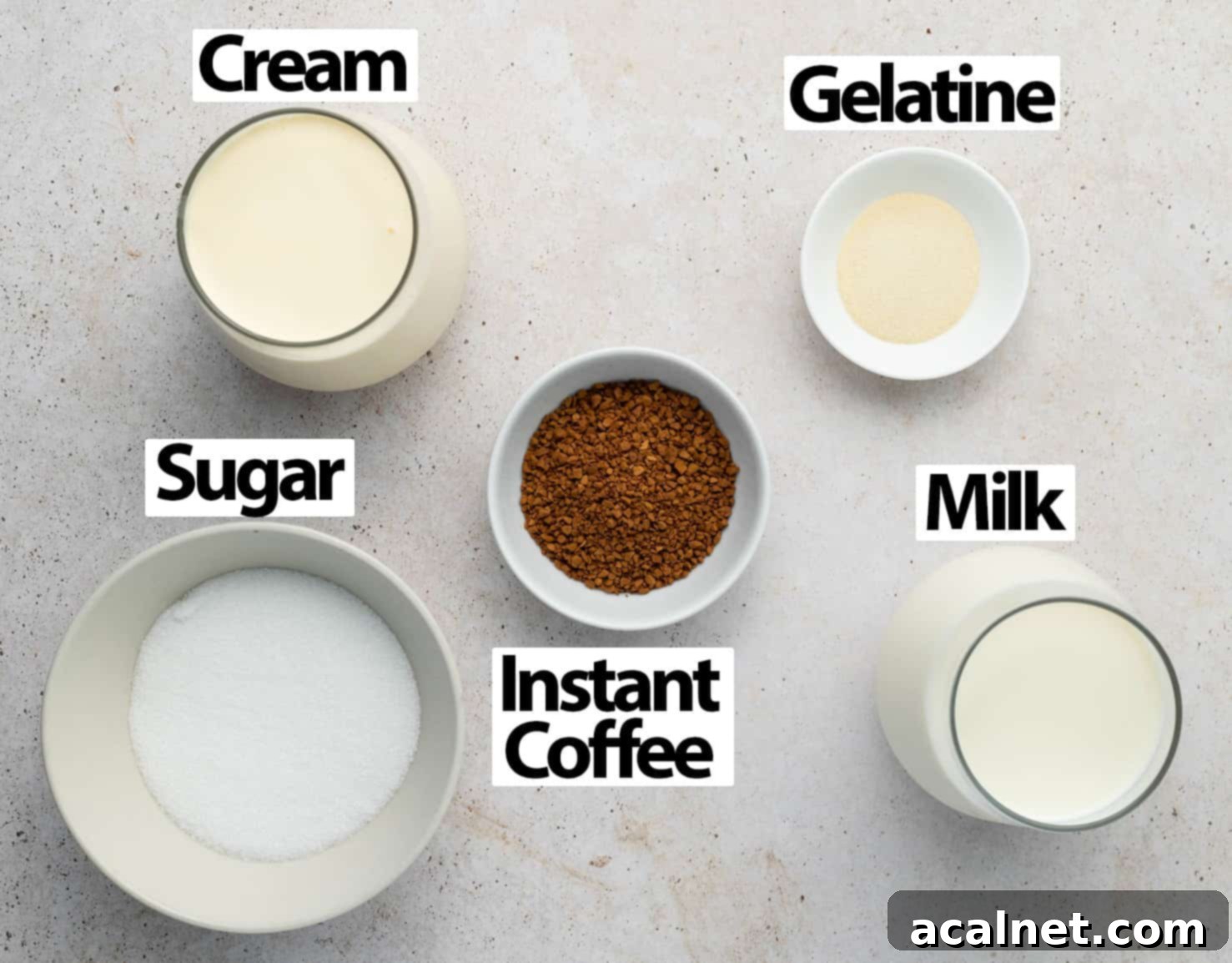
Scroll down to recipe card below for all quantities
What goes into this delightful coffee panna cotta:
- Milk: Opt for Full Cream or Whole Milk. The higher fat content contributes significantly to the creamy texture and rich mouthfeel of the panna cotta. For a dairy-free alternative, you can certainly use a plant-based milk, but be mindful that it might slightly alter the richness and the final flavor.
- Cream: Thickened or Heavy Cream is essential, ideally with at least 30% fat content. This is where a large portion of the panna cotta’s luxurious creaminess comes from. Similar to milk, a plant-based cream can be used for a dairy-free version, but ensure it has a comparable fat percentage to achieve a similar set and texture. Do note that some plant-based creams have distinct natural flavors that could subtly influence the overall taste of your dessert.
While you could make panna cotta with just milk for a lighter result, or just cream for an incredibly rich dessert, I’ve found that a balanced mix of both delivers the most perfect outcome: a dessert that is both delightfully light and deeply creamy, without being overly heavy.
- Sugar: Caster sugar or a fine white granulated sugar is recommended. Its fine texture dissolves quickly and evenly, ensuring your panna cotta is perfectly sweetened without any grittiness.
- Coffee: For convenience and excellent flavor, instant coffee granules are ideal. Instant espresso powder is also a fantastic choice, providing a more intense and robust coffee kick. If your chosen coffee doesn’t fully dissolve upon heating, a quick strain through a fine-mesh sieve before adding the gelatin will ensure a perfectly smooth mixture. For an even more profound coffee flavor, consider steeping coarsely crushed fresh coffee beans in the warm milk and cream mixture overnight before straining and proceeding with the recipe.
- Gelatin: This is the setting agent for our panna cotta. I typically use platinum strength gelatin powder, dissolved first in a small amount of cold water to “bloom.” The correct quantity of gelatin is crucial for that characteristic delicate wobble. If you prefer to use gelatin sheets, please refer to our FAQs section below for an easy substitution guide.
For an extra layer of warmth and aromatic complexity, a teaspoon of pure vanilla extract or a touch of vanilla paste can be a wonderful addition to your coffee panna cotta mixture.
Elevate Your Dessert: Toppings & Flavor Variations
While this coffee panna cotta is absolutely divine on its own, adding a thoughtful topping can elevate it from delicious to truly spectacular. My personal favorite is a simple dollop of freshly whipped cream, lightly dusted with a sprinkle of fine espresso powder for an extra burst of coffee aroma and a visual flourish. This optional step adds a lovely contrast in texture and a hint of airy sweetness.
For those who crave an even more decadent experience, consider pairing the creamy coffee base with a rich chocolate topping. Options like a silky chocolate crémeux, the velvety smooth namelaka, or a light and fluffy chocolate whipped ganache would be divine. Alternatively, stick with whipped cream and enhance it with finely shaved chocolate, elegant chocolate curls, or even playful chocolate sprinkles for a touch of whimsy. Other fantastic toppings include a drizzle of rich caramel sauce, a sprinkle of flaky sea salt (to contrast the sweetness), or a few roasted coffee beans for a textural crunch.
Step-by-Step Guide: Crafting Your Perfect Coffee Panna Cotta
Making this Coffee Panna Cotta is an incredibly straightforward process, broken down into a few simple steps. Follow along to create a flawless, restaurant-quality dessert right in your own kitchen.
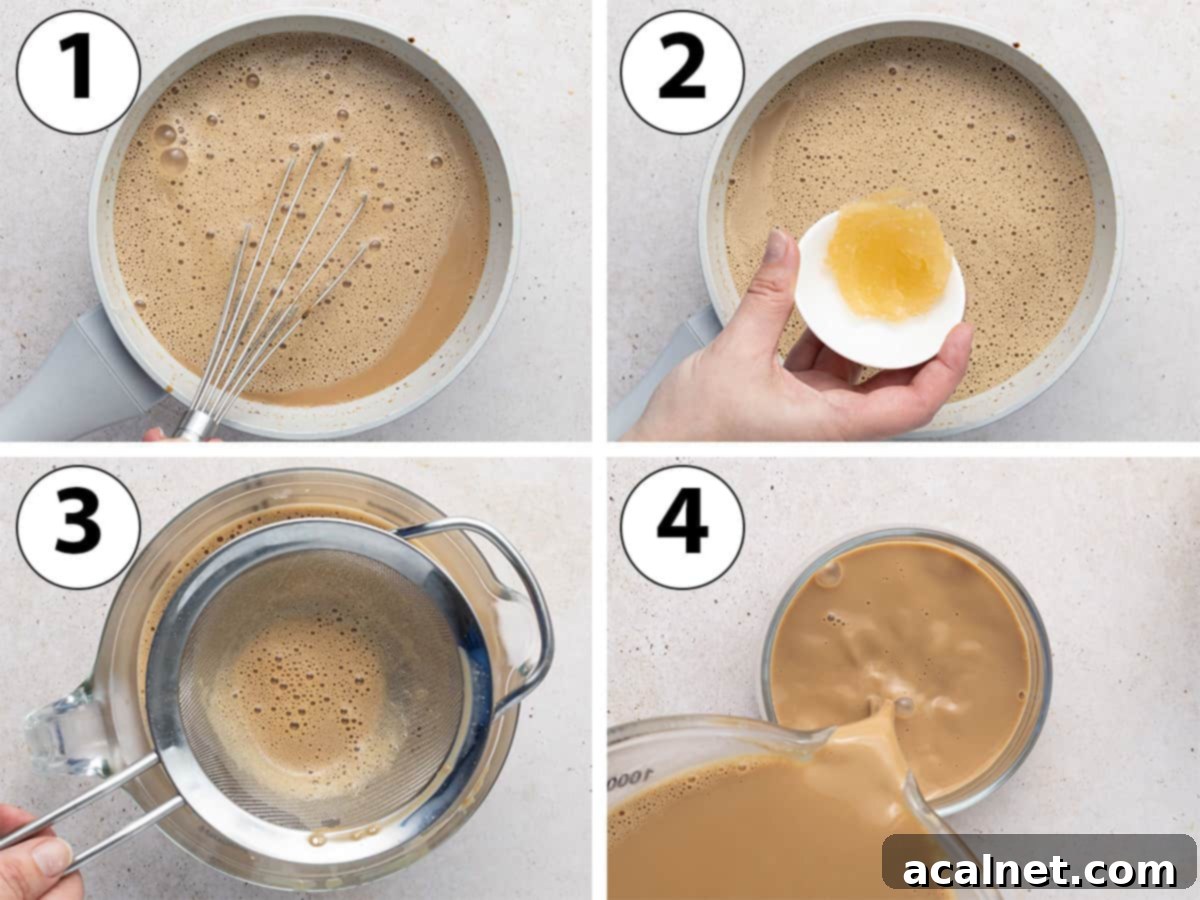
- Begin by combining the milk, heavy cream, caster sugar, and instant coffee granules in a small saucepan. Whisk these ingredients together thoroughly to ensure they are well combined.
- Photo 1: Place the saucepan over medium-low heat. Continue to whisk gently and consistently until the coffee granules have completely dissolved and the mixture reaches a gentle simmer. As soon as you see small bubbles forming around the edges, remove the saucepan from the heat. Remember, there’s no need to bring the liquid to a rolling boil, as gelatin melts and activates at a lower temperature, around 40 degrees Celsius.
- While the cream mixture is heating, prepare your gelatin. In a small, separate bowl, sprinkle the gelatin powder over 1 to 2 tablespoons of very cold water. Stir it well to combine, then set it aside for a few minutes. You’ll notice it will “bloom” and transform into a thick, translucent paste. This step is crucial for ensuring the gelatin dissolves smoothly into your panna cotta mixture.
- Photo 2: Once the cream mixture is off the heat, immediately add the bloomed gelatin paste to the warm liquid. Whisk vigorously and continuously until the gelatin is completely dissolved and no lumps remain. The residual heat from the cream mixture will be sufficient to melt the bloomed gelatin.
If you’re using gelatin leaves instead of powder, place them in a bowl of very cold water to soften before you even start heating your cream. Once your liquid is hot and off the stove, gently squeeze the softened leaves between your hands over the sink to remove excess water, then stir them directly into the warm cream mixture until fully dissolved.
- Photo 3: For a perfectly smooth and uniform panna cotta, pour the entire coffee mixture through a fine-mesh sieve into a large jug. This step helps to catch any undissolved coffee bits, gelatin lumps, or air bubbles, ensuring a luxuriously smooth final product.
- Photo 4: From the jug, carefully pour the strained panna cotta mixture into your chosen serving vessels. Dessert cups, elegant glasses, or individual ramekins all work beautifully.
- Place the filled cups into the refrigerator to chill for a minimum of 3 hours, but preferably overnight. The panna cottas are fully set when they are firm to the touch but still retain a delicate wobble when gently shaken.
Serve your gorgeous Coffee Panna Cotta as is, or enhance it with a swirl of lightly sweetened whipped cream (made by whipping heavy cream with a touch of icing sugar) and a light dusting of instant coffee powder right before serving.
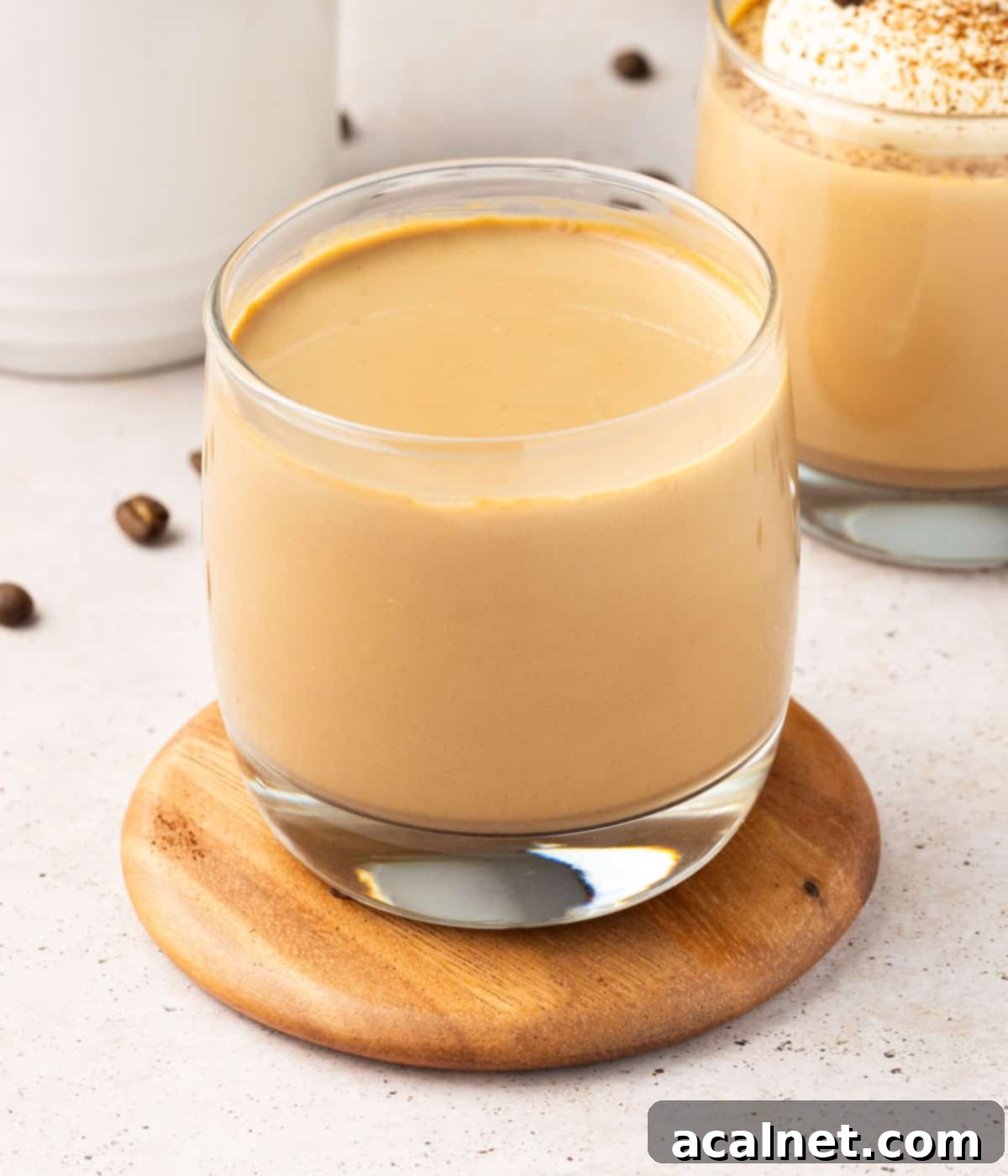
Recipe FAQs
While both panna cotta and custard boast a wonderfully creamy texture and are often served as desserts, they are fundamentally different. The primary distinction lies in their setting agents: panna cotta achieves its delicate wobble and firmness through the use of gelatin, whereas traditional custards are thickened and set by cooked eggs (either whole eggs or just egg yolks), sometimes in combination with a starch. This difference results in subtle variations in their texture and preparation methods, with panna cotta typically having a lighter, more ethereal jiggle compared to the often denser, richer consistency of a classic custard.
I’ve used platinum strength gelatin powder for this recipe. If you prefer to use gelatin sheets, the general rule of thumb for substitution is to use 2 platinum strength gelatin sheets for every 1 teaspoon of gelatin powder. Therefore, for this coffee panna cotta recipe, which calls for 7g (2 teaspoons) of gelatin powder, you would need approximately 4 platinum strength gelatin sheets. Remember to bloom gelatin sheets in a bowl of very cold water for 5-10 minutes until softened before squeezing out excess water and whisking them into your warm cream mixture.
Yes, you absolutely can use agar agar powder as a vegan alternative to gelatin, but it’s important to note that the preparation steps will differ slightly. Agar agar is derived from seaweed, is much stronger than gelatin, and activates at a higher temperature. To substitute, bring your coffee cream mixture to a full boil (unlike with gelatin, where a simmer is sufficient). Once boiling, whisk in approximately 1/2 to 3/4 teaspoon of agar agar powder (adjusting the quantity based on your desired firmness – less for a softer set, more for a firmer jelly-like texture). Continue whisking over medium heat for 2-3 minutes to ensure the agar agar fully dissolves and activates. Be quick when pouring into serving cups, as agar agar begins to set as soon as the temperature starts to drop. The final texture with agar agar will be slightly firmer and less “wobbly” than with gelatin.
If your panna cotta doesn’t set, it’s usually due to one of two reasons: either the gelatin wasn’t properly dissolved, or there wasn’t enough gelatin for the liquid volume. To troubleshoot, you can gently reheat the mixture in a saucepan over low heat, whisking constantly until it’s warm enough to dissolve the gelatin completely (around 40°C/104°F), but avoid boiling. If you suspect not enough gelatin was used, you could dissolve a little more gelatin powder in a small amount of cold water, bloom it, then stir it into the gently reheated mixture. Strain it again and re-chill for several hours or overnight.
Unmolding panna cotta can be a beautiful presentation. First, lightly grease your ramekins or molds with a neutral oil before pouring the mixture. Once fully set, briefly dip the bottom of the mold into hot water for about 10-15 seconds. Then, run a thin knife around the edge of the panna cotta to loosen it. Place a serving plate on top of the mold and carefully invert it. The panna cotta should gently slide out. If it sticks, repeat the hot water dip for a few more seconds.
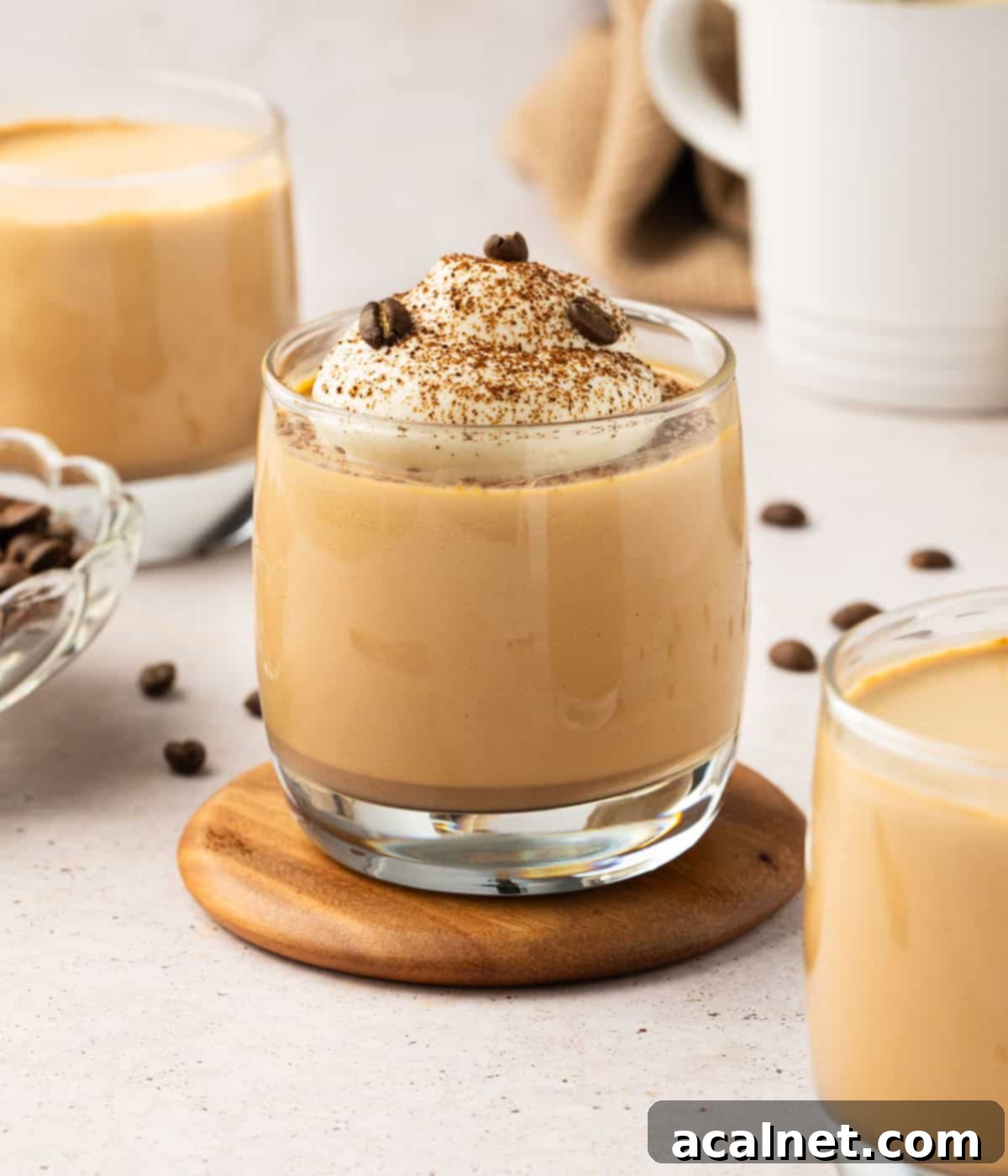
Expert Tips for Panna Cotta Perfection
- The characteristic delicate texture of panna cotta is all about the right balance of gelatin. I prefer my panna cotta on the lighter, creamier side with a beautiful wobble, which is achieved with a relatively modest quantity of gelatin. If you desire a firmer, more jelly-like texture, you can slightly increase the amount of gelatin. Experimentation is key to finding your personal preference!
- Gelatin strength varies by brand and type (e.g., gold, silver, platinum). This recipe specifically uses platinum strength gelatin powder. If you’re using a stronger or weaker gelatin, you may need to adjust the quantities accordingly. Always check the manufacturer’s instructions for specific ratios.
- To achieve the most intense and authentic coffee flavor, go beyond instant coffee. Crush some fresh coffee beans (medium grind) and let them infuse in the warm milk and cream mixture overnight in the refrigerator. The next day, simply strain the liquid through a fine-mesh sieve to remove the beans, and then proceed with the recipe as directed, adding your sugar and bloomed gelatin. This cold infusion method extracts a deep, nuanced coffee essence.
- For an ultra-smooth panna cotta, ensure your sugar and coffee granules are completely dissolved before adding the gelatin. Any undissolved particles can lead to a grainy texture. Straining the mixture through a fine-mesh sieve is also a non-negotiable step to catch any tiny impurities or air bubbles, guaranteeing a velvety finish.
- Always serve panna cotta well chilled. It allows the flavors to fully develop and ensures the perfect wobbly texture.
Storage and Make-Ahead Brilliance
One of the many charms of Coffee Panna Cotta is its incredible suitability as a make-ahead dessert. This allows you to prepare it hours, or even a full day, in advance, making entertaining a breeze. Once prepared, your coffee panna cotta should be stored covered in the refrigerator. It is best enjoyed within two to three days for optimal freshness and texture. For the best presentation and taste experience, I recommend adding any desired toppings – such as whipped cream or chocolate shavings – just before you plan to serve the dessert.
It’s important to note that panna cotta does not freeze well. Freezing and thawing can significantly alter its delicate texture, often resulting in a grainy or watery consistency due to the separation of dairy components and the breakdown of the gelatin structure. Therefore, it’s always best to enjoy this dessert fresh from the fridge.
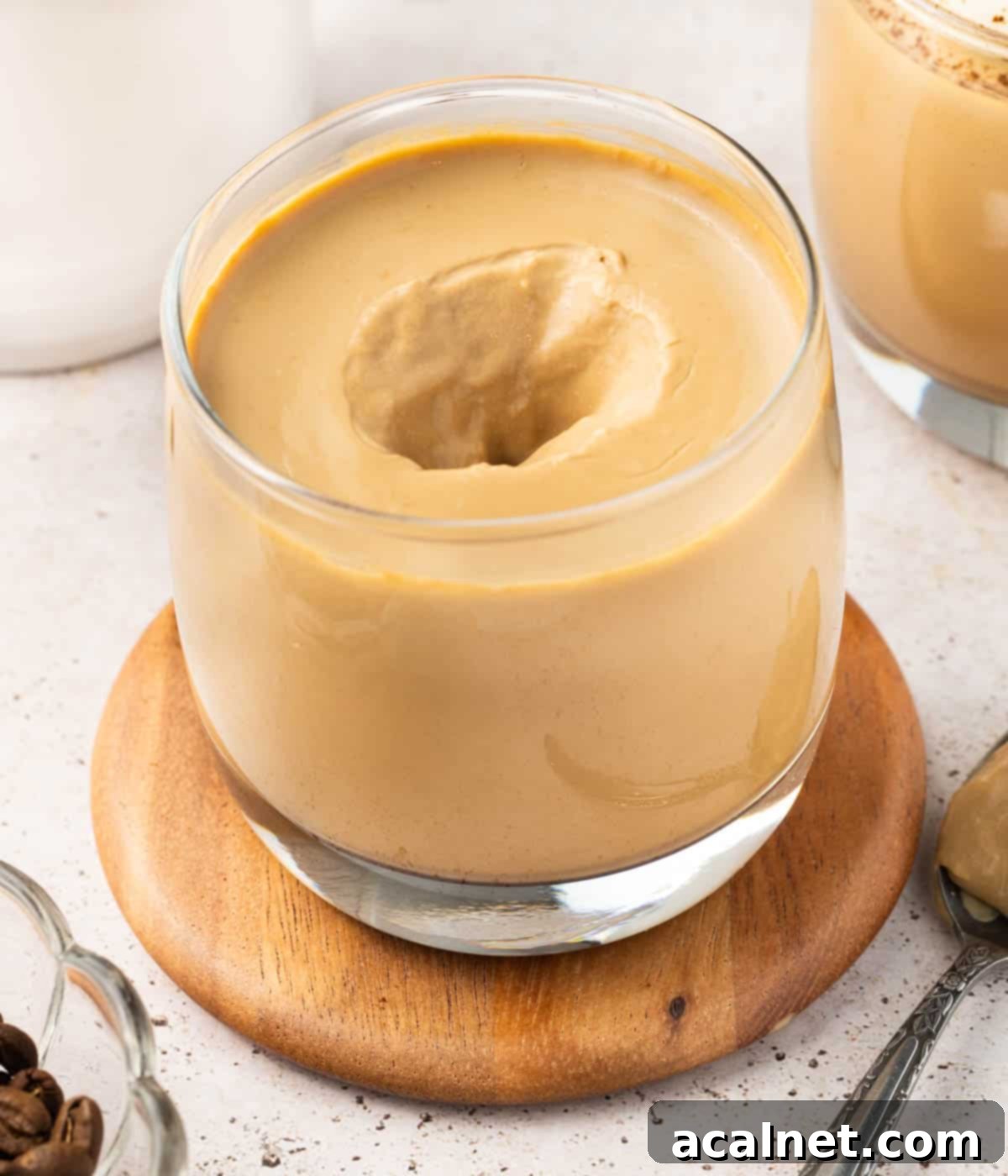
More Coffee Desserts to Explore
- Coffee Crème Brûlée
- Coffee Choux Buns
- Baked Coffee Cheesecake
- Coffee Loaf Cake
- Coffee Financiers
- Cinnamon Coffee Rolls
- Coffee Mousse Cups
Made this recipe?
Let us know if you liked it by leaving a comment below, and tag us on Instagram @a.baking.journey with a photo of your creation!
Recipe
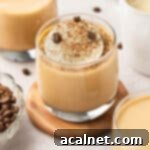
Coffee Panna Cotta
Print Recipe
Ingredients
Coffee Panna Cotta
- 360 ml Full Cream / Whole Milk
- 360 ml Thickened / Heavy Cream, 30% fat content
- 80 gr Caster Sugar
- 15 gr Instant Coffee Granules, or instant espresso powder
- 7 gr (2 teaspoon) Gelatine Powder, + 1 tablespoon cold water
Whipped Cream (optional)
- 120 ml Thickened / Heavy Cream, 30% fat content min.
- 20 gr Icing Sugar
- Espresso Powder, to taste
Instructions
Coffee Panna Cotta
- Place the milk, cream, sugar and instant coffee granules in a small saucepan. Place on medium-low heat and whisk well until fully combined and the coffee has completely dissolved. Bring to a simmer then remove from the stove (see note 1).
- While the liquids are heating up, prepare the gelatin mixture: sprinkle the gelatin powder in a small bowl and add 1 to 2 tablespoon of very cold water. Stir well to combine then set aside for a few minutes or until it has set into a thick paste (see note 2).
- Away from the heat, add the gelatin paste to the warm cream mixture and whisk really well until it has completely dissolved.
- Pour the coffee panna cotta mixture into a large jug through a thin-mesh sieve to remove any air bubbles or undissolved bits of coffee. From the jug, pour the mixture into your choice of dessert cups, glasses, ramekins or serving dishes.
- Refrigerate for at least 3 hours, preferably overnight. The coffee panna cotta should have set but still be wobbly.
Whipped Cream (optional)
- Before serving (or up to 1 hour in advance), prepare the whipped cream topping: place the cold cream and sifted icing sugar in a large bowl (if using a hand mixer) or the bowl of a stand mixer fitted with the whisk attachment.
- Whisk on medium speed for 3 to 5 minutes or until the cream starts to thicken, then slowly increase to high speed until you get the desired whipped cream consistency (see note 3).
- Place a dollop or cream over each set panna cotta, or use a pastry bag fitted with a large round piping tip to pipe the whipped cream into a small mound. Sift a little bit of fine espresso powder over the cream and serve straight away.
Would you like to save this recipe?
We’ll email this post to you, so you can come back to it later!
Notes
- You don’t need to bring the liquid to a boil; gelatin melts and fully dissolves at around 40 degrees Celsius (104 degrees Fahrenheit). A gentle simmer is perfectly sufficient.
- If using gelatin leaves, place 4 platinum strength gelatin sheets in a bowl filled with very cold water to soften for 5-10 minutes before starting to heat up the liquids. Once the cream mixture is hot and off the stove, gently squeeze the softened leaves between your hands over the sink to strain and remove as much excess water as possible, then stir them directly into the warm mixture until completely dissolved.
- It is easy to over-whip the cream, which will result in a slightly grainy or curdled texture. Once the cream starts to reach your desired consistency (soft to medium peaks), decrease the mixer speed to low or switch to a hand-held whisk to finish, giving you more control and preventing over-whipping.
Nutrition (per serving)
